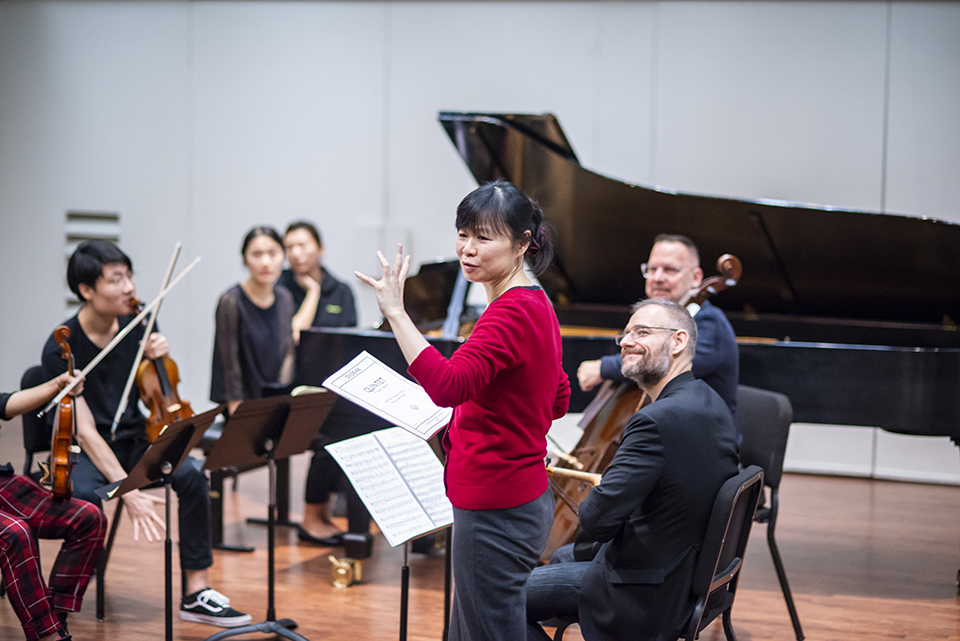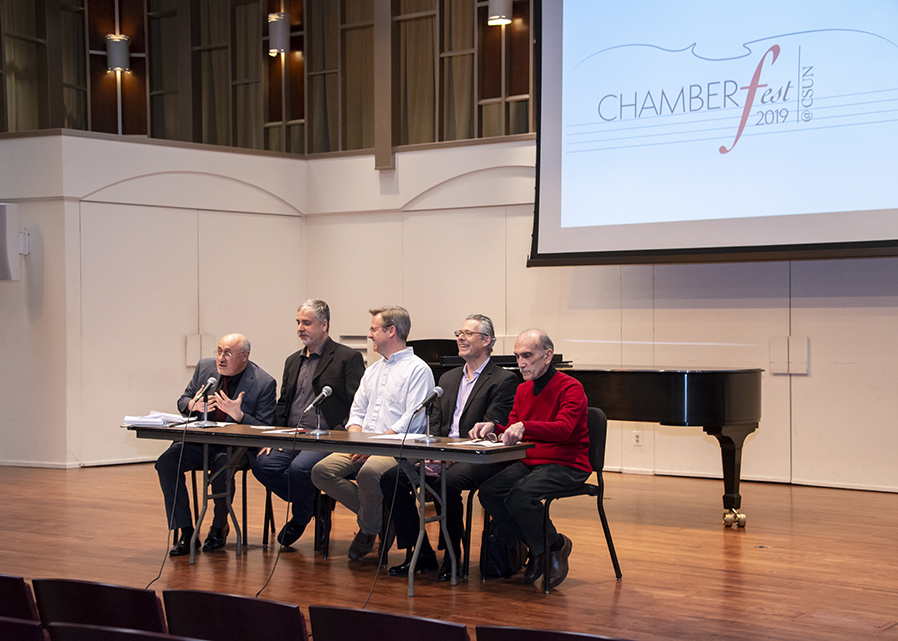Chamber Music Takes the Spotlight with Four-Day Festival
On Jan. 24, in the intimate setting of California State University, Northridge’s Cypress Recital Hall, Liviu Marinescu’s piece “Moto Perpetuo” began with just the strings. With faculty member Lorenz Gamma on the violin and Los Angeles local Dustin Seo on the cello, the two melodies began to overlap. Moments later, CSUN graduate student Larry Kaplan ’14 (Music Performance – Woodwinds) made his entrance on the flute. The three instruments seemed to converse with each other, followed by the sparing notes of Ming Tsu’s piano.
As the musicians listened and responded to one another, the music’s melody evoked the sensation of slipping into a dream — a dream which might even become a nightmare. Like sailors navigating a ship across a stormy sea, the intensity of the strings whipped the listener into a windy, wild world of the unknown.
“The title of the piece, ‘Moto Perpetuo,’ gives you an idea as to what the piece is about — perpetual motion,” said Liviu Marinescu, the work’s composer and head of the Composition Program in CSUN’s Department of Music. “While it moves very fast and has very complex rhythmic patterns — it is not repetitive — there is always something changing and shifting.”
The evening was the first of many events in the “ChamberFest @ CSUN” festival — four days of chamber music performances, lectures and master classes hosted by CSUN’s Mike Curb College of Arts, Media, and Communication, highlighting the talents of visiting musicians, faculty, alumni and students in the music department.
“It is not very often that a school puts together a short but comprehensive festival of this type featuring musicians such as the LA Philharmonic, CSUN faculty and international musicians working together, as well as student performances, master classes and lectures,” said Dmitry Rachmanov, co-director of the festival and chair of keyboard in the Department of Music. “All of these put together create a unique event that spotlights our department, and it really helps to recognize us as a leading institution.”
ChamberFest was designed to explore the art of chamber music and to provide world-class entertainment by distinguished chamber musicians, as well as an opportunity for students to learn more about the process of composing, creating and performing chamber music.
The art of chamber music is inherently intimate, given that it is performed by a small ensemble. Chamber music is played one musician to a part, with no two instruments playing the same musical line.
“Because chamber music is designed for one player per part, versus the orchestra, it offers an opportunity for a musician to be both an individual and a collaborator on a team,” said Gamma, co-director of the festival and head of string studies in the Department of Music. “The wonderful thing about chamber music is that it has this social component. The audience gets to be closer up than in an orchestral performance, and gets to be inside the experience of the immediacy of making music in real time. They get to see something in front of their very eyes that is truly personal, collaborative and spontaneous.”
Participating in active listening is crucial to any successful performance.
“When performing chamber music, you have to always be alert,” Rachmanov said. “You have to react to what the other performer is doing, which teaches you how to listen intently and respond in the right way to create a convincing performance. For students, it’s one of the few ways of expressing themselves where they have to be at once both independent and collaborative.”
Exploring a range of rich musical literature, from Beethoven to Schubert, Dvořák to Prokofiev, the master classes, performances and lectures offered a close look at musical greats and the art of chamber music as a whole.
The classes included instruction from a range of musicians, including Bin Huang, a master violinist and director of orchestral studies from the China Conservatory in Beijing; Alan Chapman, a KUSC radio host, educator and lecturer and who is a regular speaker on the Los Angeles Philharmonic’s “Upbeat Live” series; and Yuan Sheng, a pianist from the Central Conservatory of Music in Beijing.
The Department of Music hopes to continue this celebratory and comprehensive festival in years to come, with the intention of inspiring the CSUN community and greater LA community alike to engage in and support chamber music.
Prior to the performance of Marinescu’s piece, a panel discussion titled, “The Creation of Chamber Music – a Composer’s Perspective” — moderated by the directors of the event, Gamma and Rachmanov — discussed the importance of chamber music and the composition process as a whole. The panel featured Frank Campo, Marinescu and Arthur McCaffrey, all of whom are world-class composers and musicians, as well as professors at CSUN.
“You have to think in a different mindset when you write for the orchestra,” said Marinescu.
Much like his piece, chamber music is always changing and shifting, dependent on individual players as they weave together a cohesive composition in a collaborative fashion.
“Our goal was to have a positive effect on our entire school — not just chamber music, but to bring our students and faculty together, as well as musicians from around the world,” Gamma said. “These activities were there to enrich our students’ studies, and for our faculty to exchange and collaborate with other musicians. That sort of exchange is part of the mission of any university.”






 experience
experience